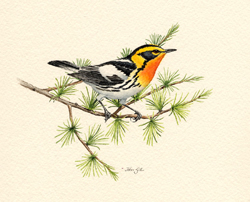Breeding Bird Atlases (BBA)
Find a Bird - BBA1
Breeding Bird Atlas 1 Species Accounts
Blackburnian Warbler
Dendroica fusca
Egg Dates
June 6 to July
Number of Broods
one; sometimes two; may re-lay if first attempt fails

Because the Blackburnian Warbler prefers either deep evergreen woods of spruce, fir, pine, and hemlock or mixed forest with large stands of hemlock and White Pine as a breeding site, it is primarily a bird of the more northern and western parts of the state. It is widely distributed in the higher elevations of Worcester County and is well established throughout Franklin County and in the western portions of Hampshire and Hampden counties. The species is found throughout Berkshire County, which represents its center of abundance in the state due to extensive areas of suitable habitat. In eastern Massachusetts, the Blackburnian Warbler is found breeding only in a few areas of Middlesex County and also in portions of Essex County; it is absent from the entire southeastern section of the state. Although there are literature reports that this species avoids White Pine, this is certainly not the case in many sections of the Commonwealth.
Breeding birds begin to appear in late April, with the majority arriving during the first week of May. However, many migrants continue to pass through the state during May en route to the extensive nesting grounds to the north. The highly territorial males fight and chase one another through the treetops, and the density of breeders is determined by the suitability of the habitat. In especially attractive areas, the birds are often found clustered in a series of adjacent territories, but in less desirable regions the birds are more widely spaced and territories may be isolated.
During courtship, the males may chase the females on rapid, twisting flights through the foliage. Their thin, wiry song is delivered from elevated, exposed perches. As is the case for many warbler species, male blackburnians have two main types of songs, both of which are highly variable. A good representation of each song type would be sleecha, sleecha, sleecha, sleecha, slee (upslurred ending) and tche-see, tche-see, tche-see, tche. Both sexes have a chip note and a high, thin seet note. Young birds give a begging call, zee-zee, zee-zee, zee-zee, very similar to that of the young of the Magnolia Warbler.
Blackburnian Warbler nests are almost always built in a conifer, from 6 to 80 feet above the ground, and are positioned well out from the trunk on a horizontal limb or in a small fork of branches near the treetop. Two females in Worcester County were observed carrying nesting materials on May 22 and June 9, respectively. In each case, the birds disappeared into the high branches of White Pines at least 40 feet above the ground. A nest found near Winchendon was located 30 feet up in a Black Spruce and 6 feet out from the trunk. It was well hidden by the tree’s needles and old man’s beard lichens. In Pelham, a nest was discovered in a somewhat unusual situation 18 feet high near the top of a Red Cedar in a fairly open area of young growth 150 yards from pine-hemlock woods where the male usually sang (Nice 1932). Nests are constructed of twigs and lichen and are lined with fine hair, dry grass, and rootlets. Four eggs make up the usual clutch, but five are sometimes produced. A Worcester County nest contained four eggs on June 26 (DKW).
The incubation period is believed to be 11 to 12 days. Nest building and incubation are carried out mainly, if not entirely, by the female, but males do help feed the young. After leaving the nest, the young are fed by the parents for several weeks, during which time they also begin to forage on their own and become increasingly independent. Nestlings have been recorded in the state from June 14 to June 24 and fledglings from June 24 to August 27 (Nice 1926, 1932; Blodget). Young fledglings were observed in Pelham on June 24 (a known fledge date), July 16, and August 1. One pair had a brood of three or four young (Nice 1926). A female in Boylston was feeding one large youngster on August 27. Blackburnian Warblers are known to renest if the first attempt fails, but, as is the case also with the Black-throated Blue Warbler, the late dates for dependent young suggest that two broods may be reared on occasion.
During late July and August, the young birds undergo a partial molt into their winter plumage. Also at this time, as the family groups break up, the adults undergo a complete molt. Both young and adults then join mixed-species flocks, which roam through the woods and woodland borders. Although they continue to prefer to feed high in the trees, they will at times descend to forage among groups of lower-feeding species.
By late August, most of the resident birds have left the breeding grounds and started their southward fall flight. Migrants continue during September, with a few still present in early October. After this, the species is encountered only as a straggler. During both spring and fall migration, Blackburnian Warblers occur throughout the state. They are less restricted to conifers during these periods and may be found in deciduous woods, shade trees, and even shrubby, secondary-growth vegetation. The wintering grounds are mainly in Colombia, Venezuela, and Peru.
Map Legend and Data Summary
Atlas 1 data collected from 1975-1979


Note: uncommon to fairly common in coniferous forest of hill country; local in hemlock stands in northeastern region
W. Roger Meservey



